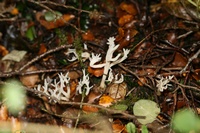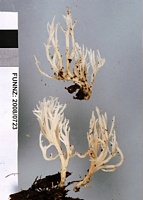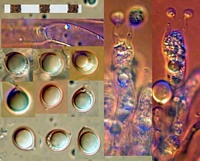|
 Clavulina cristata var. zealandica Clavulina cristata var. zealandica
BiostatusPresent in region - Indigenous. Endemic
Images (click to enlarge)
Owner: I. Dickie | 
Owner: J.A. Cooper | 
Owner: J.A. Cooper |
Article: Petersen, R.H. (1988). The clavarioid fungi of New Zealand. New Zealand Department of Scientific and Industrial Research, Bulletin 236: 170 pp. Wellington:.
Description: Fruit bodies up to 8 x 3 cm, sparsely to copiously branched, more or less arbuscular. Stipe discrete, white below, concolourous with branches above, channeled and grooved in cross section, solid to firmly stuffed, arising from a small mass of mycelium lacking a basal pad. Branches in 2-4 ranks, arising irregularly, usually flattened (at least below), palmatifid, whitish ("pale cinnamon-pink", "cartridge-buff") when very young, slowly changing to dull light pinkish cinnamon ("pinkish buff", "vinaceous buff", "cinnamon-buff", "light pinkish cinnamon"), drying greyish avellaneous; hymenium unilateral below, amphigenous upward, upward often nodulose or papillate; axils acute to rounded; internodes very irregular. Apices cristate to shortly acerose to prolonged, subulate or flagelliform, usually paler in colour than branches. Odour and taste negligible.
Tramal hyphae of branches inflated up to 10 gm diam., free, somewhat thick-walled (wall up to 0.8 gm thick), hyaline, free, clamped, generally parallel. Subhymenium of inflated, tortuous cells. Hymenium thickening; basidia 50-60 x 7-8 gm, cylindrical, clamped, multiguttulate when mature; post-partal septation occasional; sterigmata 2, stout, divergent-curved.
Spores (see Fig. 54) 8.3-10.1 x 7.6-8.3 gm (E =1.09¬1.33; E'" =1.20; L'" = 9.40 gm), subglobose to broadly ovate, thin-walled, opalescent in content; hilar appendix small, papillate.
Habitat: On humus or woody debris under Nothofagus
Notes: Clavulina taxa with clamped hyphae but no cystidia are a problem for taxonomists. Colours seem to approach grey or other sombre pastels, spores are rather consistent in size, and fruit body stature is very variable within collections, much less within taxa. The variety here is no exception. In colour and stature collections resemble C. subrugosa, but when dried, fruit bodies become sordid grey, and spores are too large to match those of C. subrugosa. I cannot find another taxon which closely matches this, and it is so close to other varieties of C. cristata (i.e., C. cristata var. bicolor Donk), that taxonomically I feel justified in treating it in this way. Conversely, I strongly suspect that C. cristata does not fruit in the Southern Hemisphere, and consequently I am uncomfortable about proposing this taxon under this species epithet.
In the literature there are few notes on colours of very young fruit bodies. In some taxa in which the adults are pigmented, the juveniles are also, but in others, fruit bodies are first white or whitish, but become suffused with colour, probably as pigment in the basidia. The above variety is so, being first off-white and then changing colour ontogenetically.
I am not familiar enough with the Pacific taxa of Clavulina to successfully distinguish the taxon with certainty. It differs from C. cavipes Corner in solid to stuffed flesh, and in lacking gloeoplerous hyphaein the trama. C. decipiens Corner produces almost uninflated, thick-walled tramal hyphae and pale tan spores.
|